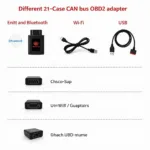OBD2 scanners have become essential tools for vehicle diagnostics, allowing mechanics and car enthusiasts to delve into the inner workings of their cars. But have you ever wondered about the language these scanners use to communicate with your vehicle’s computer? It all boils down to OBD2 data reading commands. These commands, essentially standardized requests for information, are the key to unlocking a treasure trove of data about your car’s performance, emissions, and overall health.
Think of it like this: your car’s computer is a library full of information about its past and present. OBD2 commands are like the library’s card catalog, allowing you to request specific data points or “books” from the vast collection stored within the vehicle’s system.
Deciphering the Language of OBD2 Commands
OBD2 commands, also known as Parameter IDs (PIDs), are standardized codes that request specific pieces of information from a vehicle’s ECU (Electronic Control Unit). These commands are formatted in a hexadecimal structure, typically starting with ’01’ for current data requests or ’02’ for information related to previously stored trouble codes.
Common OBD2 Commands and Their Meanings
Let’s delve into some commonly used OBD2 commands and what they reveal:
-
0100: This command retrieves the number of Diagnostic Trouble Codes (DTCs) currently stored in the vehicle’s ECU.
-
010C: Curious about your engine’s RPM? This command delivers that data in real-time.
-
010D: This command fetches the vehicle’s speed, providing valuable information about its current operation.
-
010F: Ever wondered about your car’s intake air temperature? This command provides those readings.
-
0110: This command delivers data on the Mass Air Flow (MAF) sensor, crucial for determining the amount of air entering the engine.
These are just a few examples of the many OBD2 commands available. Each command corresponds to a specific parameter within your vehicle’s system, allowing for detailed diagnostics and performance monitoring.
The Power of OBD2 Commands for Car Owners
Understanding and utilizing OBD2 commands offers several benefits for car owners:
-
Early Problem Detection: By monitoring specific parameters, you can identify potential issues before they escalate into major problems, saving you time and money on costly repairs.
-
Improved Fuel Efficiency: Monitoring parameters like fuel trim and oxygen sensor readings can help optimize your driving habits and improve fuel economy.
-
Enhanced Performance Tuning: For car enthusiasts, OBD2 commands provide insights into engine performance, allowing for adjustments and modifications to enhance horsepower, torque, and overall driving experience.
“Understanding the language of OBD2 commands empowers car owners to become more proactive about their vehicle’s maintenance and performance,” says Emily Carter, a lead automotive engineer at CarTech Solutions. “It’s like having a direct line of communication with your car, allowing you to diagnose issues, optimize performance, and ensure a smoother, more efficient ride.”
Choosing the Right OBD2 Scanner
With a plethora of OBD2 scanners available, selecting the right one depends on your needs and budget. Basic scanners offer essential code reading and clearing functionalities, while advanced models provide live data streaming, graphing capabilities, and even manufacturer-specific diagnostics.
Conclusion
OBD2 data reading commands are the backbone of vehicle diagnostics, providing a standardized language to communicate with your car’s computer. Understanding these commands and leveraging the power of OBD2 scanners empowers car owners, mechanics, and enthusiasts alike to unlock a wealth of information, leading to better maintenance, improved performance, and a deeper understanding of their vehicles.


